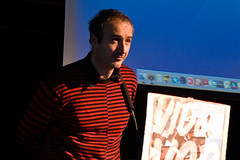Video Vortex: Dan Oki, ‘Cinema as Research Database’
The final speaker for the session Cinema and Narrativity was visual artist Dan Oki. In contrast to Jan Simons and Thomas Elsaesser, who drew on ‘old media’ to analyze the Web, Oki’s talk focused on how the database can benefit future cinema research and production.
 He began, though, by giving his perspective on issues that came up earlier in the conference. First, on the video artists’ unwillingness to go online, he says the situation is similar to an earlier one, when filmmakers ignored video art. But it is not just a case of being afraid of the new. Nor is the problem compression (limits on video quality), but how the Web enforces its own spatial and temporal logics. He discussed the problem of sculpting time – this is of course key to cinema and video, from editing to exhibition, and artists will have to figure out how this changes online. (What Oki meant exactly by this I’m not sure, and would appreciate comments on that.)
He began, though, by giving his perspective on issues that came up earlier in the conference. First, on the video artists’ unwillingness to go online, he says the situation is similar to an earlier one, when filmmakers ignored video art. But it is not just a case of being afraid of the new. Nor is the problem compression (limits on video quality), but how the Web enforces its own spatial and temporal logics. He discussed the problem of sculpting time – this is of course key to cinema and video, from editing to exhibition, and artists will have to figure out how this changes online. (What Oki meant exactly by this I’m not sure, and would appreciate comments on that.)
Oki then turned to the concept of the database and its relationship to cinema. He argues that cinema is a database, whether digitized or not. Film theory generally takes the ‘shot’ as its starting point, but a better one may be footage: 35mm stills, sound files, and so on. He gives examples, including Werner Herzog’s Grizzly Man (and I would add the equally excellent film, The Wild Blue Yonder) to show how great cinema can result from re-purposing footage. How can we use new media to nurture this kind of filmmaking? Oki says that cinema archives should be made up of footage rather than (just) films, allowing for splicing by future directors.
Databases can also help researchers make more sense of the history cinema. By importing film ‘metadata’ – cast, crew, locations, etc. – on a large scale, one can map aesthetic developments and innovation in cinema. This would help overcome the default option of attributing change to the singular visions of directors, or ‘auteurs’.
Oki’s two suggestions , archiving ‘footage’ rather than films, and creating databases for research purposes, are a useful translation of Manovich’s well-known theory of database as symbolic form into practical targets. It remains to be seen whether these will be taken up by archivists and get support from the right institutions. Then, the question will be where it will take cinema and film theory.